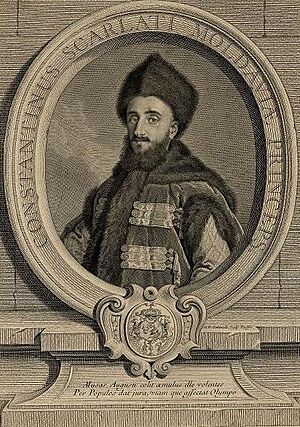Constantine Mavrocordatos facts for kids
Quick facts for kids Constantine Mavrocordatos (Κωνσταντίνος Μαυροκορδάτος) |
|
|---|---|
| Prince of Wallachia and Moldavia | |

Constantine Mavrocordatos depicted by Georg Friedrich Schmidt, 1763
|
|
| Prince of Wallachia (1st reign) |
|
| Reign | 15 September – 17 October 1730 |
| Predecessor | Nicholas Mavrocordatos |
| Successor | Mihai Racoviță |
| Prince of Wallachia (2nd reign) |
|
| Reign | 24 October 1731 – 16 April 1733 |
| Predecessor | Mihai Racoviță |
| Successor | Grigore II Ghica |
| Prince of Moldavia (1st reign) |
|
| Reign | 16 April 1733 – 26 November 1735 |
| Predecessor | Grigore II Ghica |
| Successor | Grigore II Ghica |
| Prince of Wallachia (3rd reign) |
|
| Reign | 27 November 1735 – 16 September 1741 |
| Predecessor | Grigore II Ghica |
| Successor | Mihai Racoviță |
| Prince of Moldavia (2nd reign) |
|
| Reign | 16 September 1741 – 29 July 1743 |
| Predecessor | Grigore II Ghica |
| Successor | John II Mavrocordatos |
| Prince of Wallachia (4th reign) |
|
| Reign | July 1744 – April 1748 |
| Predecessor | Mihai Racoviță |
| Successor | Grigore II Ghica |
| Prince of Moldavia (3rd reign) |
|
| Reign | April 1748 – 31 August 1749 |
| Predecessor | Grigore II Ghica |
| Successor | Iordache Stavrach |
| Prince of Wallachia (5th reign) |
|
| Reign | February 1756 – 7 September 1758 |
| Predecessor | Constantin Racoviță |
| Successor | Scarlat Ghica |
| Prince of Wallachia (6th reign) |
|
| Reign | 11 June 1761 – March 1763 |
| Predecessor | Scarlat Ghica |
| Successor | Constantin Racoviță |
| Born | February 27, 1711 Constantinople, Ottoman Empire |
| Died | November 23, 1769 (aged 58) Iași, Moldavia |
| Dynasty | Mavrocordatos family |
Constantine Mavrocordatos was an important Greek noble. He lived from 1711 to 1769. He served as Prince of Wallachia and Moldavia many times. These were two important regions in what is now Romania. He ruled between 1730 and 1769.
As a ruler, he made big changes to the laws. He improved how people paid taxes. He also helped serfs (people tied to the land). He made their lives better and treated slaves more kindly.
Contents
Life of a Prince
Constantine Mavrocordatos was born in Constantinople (today's Istanbul). His family, the Mavrocordatos, were powerful Phanariotes. This meant they were wealthy Greek families living in Constantinople. They often held high positions in the Ottoman Empire.
How Constantine Became a Ruler
Constantine took over from his father, Nicholas Mavrocordatos. He became Prince of Wallachia in 1730. He got support from the boyars, who were local nobles. He lost power that same year. But he ruled Wallachia five more times. His reigns were from 1731 to 1733, 1735 to 1741, 1744 to 1748, 1756 to 1758, and 1761 to 1763.
He also ruled Moldavia four times. These periods were from 1733 to 1735, 1741 to 1743, 1748 to 1749, and in 1769. He even got back control of a region called Oltenia. This happened after a war in 1739.
Rivalries with Other Rulers
Constantine often had disagreements with another prince, Grigore II Ghica. They would try to replace each other. A writer named Ioan Neculce noted their rivalry. He said they would complain about each other to the Ottoman Porte. The Porte was the government of the Ottoman Empire.
Important Changes and Reforms
Constantine Mavrocordatos is known for his many reforms. He changed the tax system and how the government worked. Some of his ideas came from the Habsburg monarchy. They had ruled Oltenia for a time. He started these changes in Wallachia. Then he applied them in Moldavia too.
Changes to Taxes
He got rid of several indirect taxes. These were taxes on things like cattle, called văcărit. Instead, he created one single tax. This tax was 10 löwenthaler. People could pay it in four parts each year.
Helping Serfs and Slaves
Many serfs were leaving for Transylvania. Serfs were peasants who were tied to the land. To stop this, Mavrocordatos gave them more freedom. They could move from one noble's land to another. They just had to pay a 10 löwenthaler fee. This change effectively ended serfdom in Wallachia in 1746. It ended in Moldavia in 1749.
He also made rules about what serfs had to do. They had to pay a rent. They also had to work for 12 days a year for their lord. Nobles could also have some serfs who didn't pay state taxes. These serfs, called scutelnici, only paid taxes to their lord.
Constantine also made a rule about slaves. He stopped owners from separating married Gypsies who belonged to different masters. This was a step towards more humane treatment.
Government Improvements
The prince wanted to make the government stronger. He wanted more centralism. This meant more power for the prince, less for the nobles. Nobles had many special rights. But Constantine created a more professional government. Officials were paid a salary. He appointed officials called ispravnici. They could also act as judges.
He also combined the prince's personal money with the country's money. He also decided that families could not be called "boyars" if their members no longer held official jobs. These changes helped make the government more organized.
The End of His Rule
Constantine Mavrocordatos was captured in 1769. This happened during a war between Russia and the Ottoman Empire. He was fighting in Galați. Russian troops, led by Catherine II, wounded him. He was taken to Iași and died while a prisoner. Even though nobles tried to undo his reforms, his laws stayed in place. Later rulers confirmed his changes.


